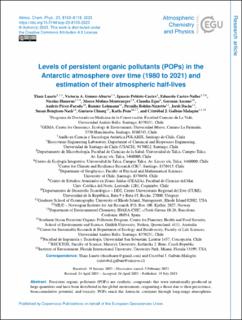| dc.description.abstract | Persistent organic pollutants (POPs) are synthetic compounds that were intentionally produced in large quantities and have been distributed in the global environment, originating a threat due to their persistence, bioaccumulative potential, and toxicity. POPs reach the Antarctic continent through long-range atmospheric transport (LRAT). In these areas, low temperatures play a significant role in the environmental fate of POPs, retaining them for a long time due to cold trapping by diffusion and wet deposition, acting as a net sink for many POPs. However, in the current context of climate change, the remobilization of POPs that were trapped in water, ice, and soil for decades is happening. Therefore, continuous monitoring of POPs in polar air is necessary to assess whether there is a recent re-release of historical pollutants back to the environment. We reviewed the scientific literature on atmospheric levels of several POP families (polychlorinated biphenyls – PCBs, hexachlorobenzene – HCB, hexachlorocyclohexanes – HCHs, and dichlorodiphenyltrichloroethane – DDT) from 1980 to 2021. We estimated the atmospheric half-life using characteristic decreasing times (TD). We observed that HCB levels in the Antarctic atmosphere were higher than the other target organochlorine pesticides (OCPs), but HCB also displayed higher fluctuations and did not show a significant decrease over time. Conversely, the atmospheric levels of HCHs, some DDTs, and PCBs have decreased significantly. The estimated atmospheric half-lives for POPs decreased in the following order: 4,4' DDE (13.5 years) > 4,4' DDD (12.8 years) > 4,4' DDT (7.4 years) > 2,4' DDE (6.4 years) > 2,4' DDT (6.3 years) > α-HCH (6 years) > HCB (6 years) > γ-HCH (4.2 years). For PCB congeners, they decreased in the following order: PCB 153 (7.6 years) > PCB 138 (6.5 years) > PCB 101 (4.7 years) > PCB 180 (4.6 years) > PCB 28 (4 years) > PCB 52 (3.7 years) > PCB 118 (3.6 years). For HCH isomers and PCBs, the Stockholm Convention (SC) ban on POPs did have an impact on decreasing their levels during the last decades. Nevertheless, their ubiquity in the Antarctic atmosphere shows the problematic issues related to highly persistent synthetic chemicals. | en_US |

